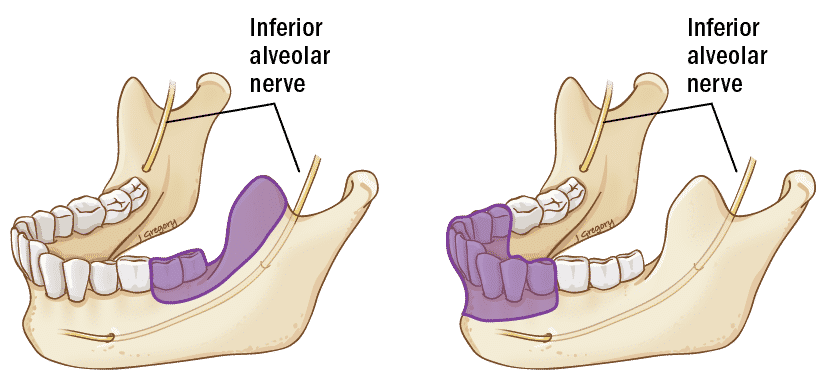If your cancer is located near or within the jawbone, a surgeon may remove a portion of your mandible (lower jaw) in a procedure known as a mandibulectomy. Additionally, if you suffer from osteoradionecrosis (bone destruction) following radiation therapy, you may need a mandibulectomy.
Of note, a mandibulectomy is different from a mandibulotomy. A mandibulotomy is a cut through the jawbone to gain exposure to the mouth/throat. After the tumor inside the mouth/throat is removed, the mandible is put back together with a plate and screws. No mandibular bone is removed in a mandibulotomy.

How to Prepare
Doctors will give their patients specific instructions regarding what to do before surgery. In general, patients should not eat or drink anything (except essential medications) any time after midnight the night before surgery. Patients should tell their doctor if they begin to feel sick before surgery.
What to Expect
On the day of surgery, the patient will likely be asked to arrive at the hospital a few hours before the scheduled operation. During this time, nurses will check the patient in and anesthesiologists will ensure that everything is safe for general anesthesia. The surgeon will also come see the patient to review the plan and answer any last minute questions.
For all of these cases, the patient will be put completely to sleep with general anesthesia. Patients may or may not require a tracheotomy and/or feeding tube to aid breathing and eating, depending on whether a marginal or segmental mandibulectomy is performed.
Types of Mandibulectomies
Marginal Mandibulectomy
In this type of surgery, only a portion of the mandible is removed, and the bone remains continuous, or whole. A saw will be used to take out a rim of the bone against where the tumor is located. This type of mandibulectomy is done when a tumor has grown up against the jawbone, but does not invade it. A marginal mandibulectomy should be performed only if the surgeon can confidently remove the entire tumor, leaving no cancerous tissue behind. A marginal mandibulectomy should not be done if the cancer clearly invades into the bone, because cancer cells can spread easily in bone, and it is difficult to confirm that any bone left behind is cancer-free without complete removal via a segmental mandibulectomy.
Segmental Mandibulectomy
In this type of surgery, a cut is made through the full thickness of the mandible, and an entire section of the bone is removed. This means that the mandible will be discontinuous (there will be a gap) and will need to be reconstructed in order to maintain the function and appearance of the patient’s jaw. In addition the patient’s remaining teeth will be out of alignment with the upper teeth as a result of a segmental mandibulectomy and the resultant shift in the jaw.
Unfortunately, this type of mandibulectomy usually requires cutting and sacrificing the mental nerve, also referred to as the inferior alveolar nerve that travels through a canal in the bone and brings feeling to the skin of the chin and the lower lip. Doctors may be able to perform a nerve graft to restore some sensation in the long term.
Often, a segmental mandibulectomy will be accompanied by a neck dissection to see if the cancer has spread to any lymph nodes in the neck. In advanced cases, part of the tongue, floor of mouth, or skin of the face will also need to be removed, depending on where the cancer has invaded. This surgery is called a composite resection because it involves the removal of multiple different types of tissue. Other associated procedures might include a tracheotomy and/or feeding tube placement as mentioned above.
There are a variety of incisions that can be utilized and will be described in detail by the patient’s surgeon. Some approaches require an incision that crosses the chin and the lower lip for maximal exposure to the inside of the mouth. For more limited tumors, the procedure may be accomplished through a “visor” incision that avoids a chin and lower lip scar. In the latter approach, the skin of the upper neck is lifted up similar to a visor in order to gain exposure to the inside of the mouth.
Reconstruction
Once a piece of the mandible has been removed, the remainder of the jaw will need to be reconstructed, so that patients can eat, and so their jaws will appear normal. The specific type of reconstruction will depend on how much of the mandible was removed and whether any other types of tissue had to be removed, along with the overall health of the patient. Patients who do not undergo any form of reconstruction will invariably experience a shift in the mandible with jaw displacement resulting from the unopposed pull of the muscles that insert into the jaw to aid in the chewing process.
For some patients who are not deemed to be good candidates for jaw reconstruction, their mandibular shape and continuity can be restored with a 3 dimensional plate and screws. This technique uses a titanium plate to bridge the gap in their mandible and can restore the occlusal relationships between the upper and lower teeth. Unfortunately, these plates are usually destined to fail due to fracture or extrusion of the plate through the skin of the face or the lining of the mouth. The risk of these complications happening varies with the location of the defect in the jaw and whether the patient has dentition and is able to resume chewing. Defects of the mandible that involve the symphysis (the front portion of the jaw) are most likely to fail due to plate extrusion.
In most cases, patients who are deemed to be suitable candidates for a longer surgical procedure should be offered a jaw reconstruction with the transfer of a bone from another part of the body (such as the leg, back, forearm or hip). This form of surgery is referred to as a free flap. The purpose of this procedure is to reconstruct the jaw and provide structural support to allow the patient to eat. Patient comorbid conditions and lack of motivation, as well as the lack of existing expertise to perform this elaborate surgery may eliminate this form of restorative surgery from consideration.
Recovery & Aftercare
When the patient first wakes up after surgery, they might have a tracheotomy tube and/or a feeding tube, and will likely have some drains in their neck to help remove any accumulated fluid and prevent infection. In some cases, their jaw may be wired closed to help keep the upper and lower teeth aligned. The patient will be given pain medications to alleviate any pain.
The recovery course will depend on the extent of the surgery and reconstruction. A patient could go home after one or two days in the hospital (marginal mandibulectomy) or could remain in the hospital for one to two weeks (segmental mandibulectomy). The recovery process may also involve physical therapy or speech and swallowing therapy after surgery.

Download This Section
Feel free to download and print this page.
It’s free for personal use and to share with others you think might benefit from the information provided.
Risks
As with any procedure, there are certain risks associated with undergoing a mandibulectomy. These include:
- Bleeding (including Hematoma)
If there is severe bleeding after the procedure, the surgeon might need to quickly take the patient back to the operating room to stop the bleeding. However, some mild bleeding or small blood collections under the skin (hematomas) can be observed without the need to return to the operating room. - Seroma
This is a collection of normal body fluid in the neck that occurs after a surgical drain is removed. This can be treated with observation, as the body will usually resorb it. Alternatively, another approach is to perform repeated needle aspiration to drain the fluid. - Infection
With any surgical procedure, especially those that involve the mouth where there are innumerable bacteria, there is a risk of an infection. This might require antibiotics and/or drainage of the infection. - Salivary Fistula
This occurs when there is a small channel (or fistula) that allows saliva to leak from the mouth into the neck. The chances of this increase if a patient has previously been treated with radiation and/or chemotherapy, which impede wound healing. Typically, the treatment of fistulas involves inserting a drain to divert the saliva away from critical structures in the neck, placing packing into the diverted tract, and allowing the body to heal on its own. In some cases, an additional surgical procedure might be required to close the leak. - Blood Clots
Patients who undergo major surgeries, especially patients who have cancer, are at an increased risk of developing blood clots in their legs (deep venous thrombosis or DVT). Sometimes these blood clots can travel through the veins and into the lungs, causing a pulmonary embolism (PE). If such a problem occurs, patients will likely require anticoagulation (blood-thinning) medication to prevent more clots from forming and ending up in their lungs. Depending on the size and extent of a pulmonary embolus, this problem can be mild or life threatening.

Top Questions for Your Doctor
Access our list of the most important questions to ask your physician at your next appointment.












